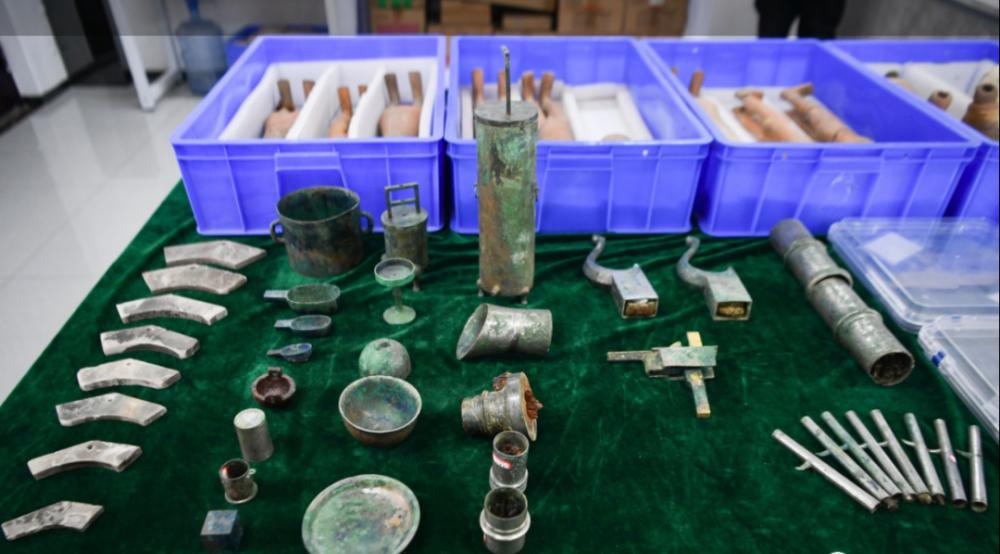The latest achievements in Chinese archaeology have created the "rule of Wenjing" of the Han Wendi, whose tomb location and scale have been confirmed, and a large number of precious cultural relics such as gold and silverware, pottery figurines, and copper seals have been excavated from the outer pits and funerary tombs around the Baling Tomb. The mystery of the "Tomb of emperor Wen of Han" was unveiled.

After entering the 21st century, archaeologists carried out a large-scale archaeological survey in the western part of Bailuyuan in the eastern suburbs of Xi'an City, Shaanxi Province, and carried out large-scale archaeological exploration of the "Phoenix Mouth" where the ancestral Tomb of Emperor Wen of Han was located, as well as the Mausoleum of Empress Dou and the Southern Tomb of Empress Bo, basically determined the general scope of the Mausoleum area of Emperor Wen of Han, the distribution of important sites and the layout of important sites, and newly discovered a "Ya" shaped tomb.
This newly discovered tomb is called the Jiangcun Tomb because it is located in Jiangcun, Baqiao District, Xi'an City. After continuous exploration and rescue excavation of some of the outer pits around the tomb, it was basically confirmed that this tomb was the tomb of Emperor Wen of Han. After archaeological investigation, this "Ya" shaped mega ancient tomb has a total of 115 such pits around it, which are distributed radially.
Archaeology excavated 8 outer pits of Jiangcun Tomb, and unearthed more than 1,500 pieces of pottery figurines, copper seals, copper carriages and horses, iron and pottery. In the K15 outer pit, which is about 40 meters long, the dense pottery figurines are particularly eye-catching, and a large number of pottery figurines are painted nude clay figurines, which are called clothed clay figurines in archaeology.
At the bottom of the outer pit there are a large number of clay figurines, which according to archaeologists counted in the thousands.
The "dressed clay figurines" unearthed in the outer pit of the Gangchon Tomb have different faces, and each figurine has its own appearance. Their arms are wooden, they can move, and they wear silk or linen clothing. With the passage of thousands of years, the arms and clothing of these clay figurines have decayed, so what everyone sees now is the naked and armless "dressed clay figurines".
Pottery horses unearthed from the Gangchon Tomb.
Historical documents record that Bo Ji was the concubine of Liu Bang, the ancestor of Han Gao, and the biological mother of Liu Heng, the Emperor of Han, and in 155 BC, Bo Ji died and was buried in Nanling. During the excavation of empress dowager Bo's southern tomb, Emperor Wendi of Han's mother, a large number of rare gold artifacts were unearthed in the steppe style. Archaeologists speculate that this may be related to the origin of Emperor Wen of Han in his early years as a "daiwang", and that the gold artifacts came from the daiguo bordering the steppe. It can be speculated that before the opening of the Silk Road, exchanges between the Central Plains and the steppe had been established.
Painted pottery figurines excavated from the Great Tomb of Gangchon and the Southern Tomb of Empress Bo.
Some cultural relics excavated from the Jiangcun Tomb and the Southern Tomb of Empress Bo.
The staff cleaned up the cultural relics excavated from the Jiangcun Tomb.
The staff inspected the copper coins unearthed from the Jiangcun Tomb.
Staff weighed copper coins excavated from the Gangchon Tomb.
Bronze artifacts excavated from the Gangchon Tomb and the Southern Tomb of Empress Bo.
Through the excavation of the outer tibetan pit at this stage, we have learned the connotation and significance of the Jiangcun Tomb or the Baling Tomb, and there are many outer hidden pits, and there is no point in digging again, so it will not be excavated.
Because of the limitations of cultural relics protection technology, experts introduced that the tomb of Emperor Wen of Han will not be excavated at present, and will be mainly protected. We will leave this cultural heritage behind for future generations. When they have a way to solve these problems, it is better to explore them. Now that the owner of the tomb has been confirmed, the main task is to protect it.